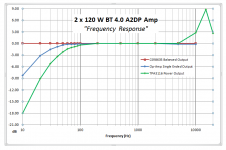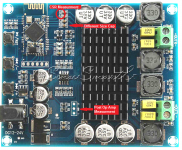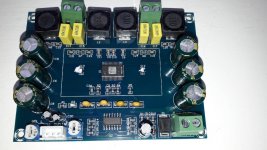I realise you can connect a balanced output to a non balanced input, but i have had all sorts of problems with earth loops in the past particularly with USB interfaces, keeping everything balanced is much better.
Re-messure and let ut know, I´m interested to know myself.
Well, you were right. The CSR8635's equalizer is not being used.
In the attached FR graph, the CSR's output is a dead straight line from 10 Hz to 20K Hz. The balanced to single ended conversion creates a 1st order HP with an Fc = 20 Hz at the inputs to the op-amp. That makes sense as the inputs use 20K resistors assuming 0.39 uF caps. Then there is another 6 dB loss at the TPA3116's power output - likely due to another HP created by DC decoupling caps and the TPA's input impedance.
As annotated on a stock pic, one of the caps on the balance/single ended conversion is not the same size as the other three (CN Quality). I measured on the side with same size caps. Up past 10K Hz, there is a jump in dB only at the power output. Not sure what causes it. I saw it on a DVM and the O-scope.
All in all, easier for most to increase the cap sizes to reduce the HP issues than reprogram the CSR's equalizer.


Last edited:
The red one I linked to? The jumper is for mute if I remember correctly.that board has a jumper with two positions, SE like most others boards and differential
Last edited:
So I modded my YJ board according to what I've learned in this thread, end result:
https://i.imgur.com/g4E5OW1.jpg
Now I stumbled upon writings by Troels Gravesen about coil placement for crossovers and find his results in this image:
http://www.troelsgravesen.dk/coils_files/coils_9.gif
Looking at the placement of the coils on my modded board, they are positioned in what Troels classifies as "very bad".
To be honest, I think my board sounds very very good.
But I'm one of those types that can't live with the idea that it could be better - if only marginally 🙂
Does the coil placement like on my board really have a (slightly) negative impact? Or is this just ghost-chasing?
https://i.imgur.com/g4E5OW1.jpg
Now I stumbled upon writings by Troels Gravesen about coil placement for crossovers and find his results in this image:
http://www.troelsgravesen.dk/coils_files/coils_9.gif
Looking at the placement of the coils on my modded board, they are positioned in what Troels classifies as "very bad".
To be honest, I think my board sounds very very good.
But I'm one of those types that can't live with the idea that it could be better - if only marginally 🙂
Does the coil placement like on my board really have a (slightly) negative impact? Or is this just ghost-chasing?
So I modded my YJ board according to what I've learned in this thread, end result:
https://i.imgur.com/g4E5OW1.jpg
Now I stumbled upon writings by Troels Gravesen about coil placement for crossovers and find his results in this image:
http://www.troelsgravesen.dk/coils_files/coils_9.gif
Looking at the placement of the coils on my modded board, they are positioned in what Troels classifies as "very bad".
To be honest, I think my board sounds very very good.
But I'm one of those types that can't live with the idea that it could be better - if only marginally 🙂
Does the coil placement like on my board really have a (slightly) negative impact? Or is this just ghost-chasing?
The Troels coil orientation "tutorial" outlines how the coil's inductance value will change from mutual inductance. IIRC, perhaps 20% for the worst case positioning.
I bought a TPA3116 2.1 board eons ago and I'm trying to determine if it has the right bootstrap caps... it's been very fruitless :|
The problem is I can't really find any info on this board and they stopped selling this design 1-2 years ago. What I'm using is an FX Audio XL2.1BL and it has BT problems and tone controls suck big time. It sounds good though.
The very same shop I got this board from replaced that with this

An externally hosted image should be here but it was not working when we last tested it.
The problem is I can't really find any info on this board and they stopped selling this design 1-2 years ago. What I'm using is an FX Audio XL2.1BL and it has BT problems and tone controls suck big time. It sounds good though.
The very same shop I got this board from replaced that with this

Last edited:
And the real world problem you have with the board or question is?
I have 2 of this 2.1 board and really like them, no problems.
I have 2 of this 2.1 board and really like them, no problems.
An externally hosted image should be here but it was not working when we last tested it.
And the real world problem you have with the board or question is?
I have 2 of this 2.1 board and really like them, no problems.
An externally hosted image should be here but it was not working when we last tested it.
my question is if it has the right bootstrap caps 😕
Btw, my board differs from yours
DJWhat I'm using is an FX Audio XL2.1BL and it has BT problems and tone controls suck big time. It sounds good though.[/QUOTE said:FYI: There was an update to the FX - new PCB version. Several on PE's Tech Talk like it. The only issue is the sub LP filter is fixed circa 160 Hz - a little high for for most.
FYI: There was an update to the FX - new PCB version. Several on PE's Tech Talk like it. The only issue is the sub LP filter is fixed circa 160 Hz - a little high for for most.
Its worse for me, its stuck in a no man's land between my 6.5 bookshelves and 8" sub...
the 8" doesn't sound boomy but for some reason it makes my bookshelves sound very boomy around crossover point
An externally hosted image should be here but it was not working when we last tested it.
I have an issue with this board. The input of the board is an Asus Xonar U7 external soundcard. I frequently use this high quality low noise soundcard for other class D amplifiers without problems. When the input of this soundcard is connected to this amplifier I get an annoying buzz. I tried the amplifier with a pre amplifier and then the buzz is gone. Is the input impedance of this amplifier not right? Can I correct this?
Its worse for me, its stuck in a no man's land between my 6.5 bookshelves and 8" sub...
the 8" doesn't sound boomy but for some reason it makes my bookshelves sound very boomy around crossover point
Actually I fixed it. Sort of. The 1800uf cap was on the verge of giving up without any obvious signs.
The SMPS whine was getting more obvious last night so I replaced it with a 2200uF YXG... ironically the same cap series as before but... was the 1800uF running in spec or out of spec? or was it fake...

I have an issue with this board. The input of the board is an Asus Xonar U7 external soundcard. I frequently use this high quality low noise soundcard for other class D amplifiers without problems. When the input of this soundcard is connected to this amplifier I get an annoying buzz. I tried the amplifier with a pre amplifier and then the buzz is gone. Is the input impedance of this amplifier not right? Can I correct this?
It is directly attached to the inputs but... the amp has a full differential opamp on the input of both channels. It has no problem from a weak source even but the buzz is probably due to loose wiring?
I'm not sure.
Last edited:
Its worse for me, its stuck in a no man's land between my 6.5 bookshelves and 8" sub...
the 8" doesn't sound boomy but for some reason it makes my bookshelves sound very boomy around crossover point
It's the fixed XO LP filter. The LP's high Fc at 160 Hz is creating too much bass with the sub and the L-R speakers both producing circa 100 Hz to 160 Hz (and drowning out the sub's low end). My analysis is here on PE's Tech Talk forum.
It's a colorful post but includes detailed technical info - measurements and reverse engineering. The amp's sub-out maintains bass output down to 20 Hz. And there's instruction on how to modify (i.e., lower) the amp's LP Fc point. If your amp has the current PCB (compared in the TT analysis) that may be a solution for you.
Last edited:
Thanks! I don't know how much longer am I going to keep using it because unless I fit it with a LPS there is quite a bit of supply hash getting to the speakersIt's the fixed XO LP filter. The high Fc is creating too much bass with the sub and the L-R speakers both producing circa 100 Hz to 160 Hz (and drowning out the sub's low end). My analysis is here on PE's Tech Talk forum.
It's a colorful post but includes detailed technical info from measurements and reverse engineering. The amp's sub-out maintains bass bass output down to 20 Hz. And there's instruction on how to modify (i.e., lower) the amp's LP Fc point.
Thanks! I don't know how much longer am I going to keep using it because unless I fit it with a LPS there is quite a bit of supply hash getting to the speakers
LPS?
LPS?
Linear power supply. I have such a trafo lying around... and 2 LT1085 boards hanging off it with a big heatsink only it isn't done 😱
- Home
- Amplifiers
- Class D
- TPA3116D2 Amp
